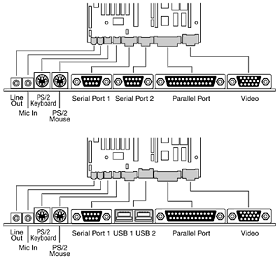LPX Motherboard
The LPX and mini-LPX form factor boards were a semiproprietary design that Western Digital originally developed in 1987 for some of its motherboards. The LP in LPX stands for Low Profile, which is so named because these boards incorporate slots that are parallel to the main board, enabling the expansion cards to install sideways.
This allows for a slim or low-profile case design and overall a smaller system than the Baby-AT. Although Western Digital no longer produces PC motherboards, the form factor lives on, and many other motherboard manufacturers have duplicated the design.
Unfortunately, because the specifications were never laid out in exact detail—especially with regard to the bus riser card portion of the design—these boards are termed semiproprietary and are not interchangeable between manufacturers.
Some vendors, such as IBM and HP, for example, have built LPX systems that use a T-shaped riser card that allows expansion cards to be mounted at the normal 90° angle to the motherboard but still above the motherboard. This lack of standardization means that if you have a system with an LPX board.
In most cases you can't replace the motherboard with a different LPX board later. You essentially have a system you can't upgrade or repair by replacing the motherboard with something better. In other words, you have what I call a disposable PC, something I would not normally recommend that anybody purchase.
Most people were not aware of the semiproprietary nature of the design of these boards, and they were extremely popular in what I call "retail store" PCs from the late 1980s through the late 1990s. This would include primarily Compaq and Packard Bell systems, as well as many others who used this form factor in their lower-cost systems.
These boards were most often used in low-profile or Slimline case systems but were found in tower cases, too. These were often lower-cost systems such as those sold at retail electronics superstores. Although scarce even in retail chains today, because of their proprietary nature, I recommend staying away from any system that uses an LPX motherboard.
LPX boards are characterized by several distinctive features. The most noticeable is that the expansion slots are mounted on a bus riser card that plugs into the motherboard. In most designs, expansion cards plug sideways into the riser card. This sideways placement allows for the low-profile case design.
Slots are located on one or both sides of the riser card depending on the system and case design. Vendors who use LPX-type motherboards in tower cases sometimes use a T-shaped riser card instead, which puts the expansion slots at the normal right angle to the motherboard but on a raised shelf above the motherboard itself.
Another distinguishing feature of the LPX design is the standard placement of connectors on the back of the board. An LPX board has a row of connectors for video (VGA 15-pin), parallel (25-pin), two serial ports (9-pin each), and mini-DIN PS/2 style mouse and keyboard connectors.
All these connectors are mounted across the rear of the motherboard and protrude through a slot in the case. Some LPX motherboards might have additional connectors for other internal ports, such as network or SCSI adapters. Because LPX systems use a high degree of motherboard port integration, many vendors of LPX motherboards, cases, and systems often refer to LPX products as having an "all-in-one" design.
I am often asked, "How can I tell whether a system has an LPX board without opening the cover?" Because of the many variations in riser card design, and because newer motherboards such as NLX also use riser cards, the most reliable way to distinguish an LPX motherboard from other systems is to look at the connector signature (the layout and pattern of connectors on the back of the board).
As you can see in Figure below, all LPX motherboards—regardless of variations in riser card shape, size, or location—place all external ports along the rear of the motherboard.

By contrast, Baby-AT motherboards use case-mounted or expansion slot–mounted connectors for serial, parallel, PS/2 mouse, and USB ports, whereas ATX-family motherboards group all external ports together to the left side of the expansion slots.
On an LPX board, the riser is placed in the middle of the motherboard, whereas NLX boards have the riser to the side (the motherboard actually plugs into the riser in NLX). Figure above shows two typical examples of the connectors on the back of LPX boards. Note that not all LPX boards have the built-in audio, so those connectors might be missing.
Other ports (such as USB) might be missing from what is shown in these diagrams, depending on exactly which options are included on a specific board; however, the general layout will be the same. The connectors along the rear of the board would interfere with locating bus slots directly on the motherboard, which accounts for why riser cards are used for adding expansion boards.
Although the built-in connectors on the LPX boards were a good idea, unfortunately the LPX design was semiproprietary (not a fully interchangeable standard) and thus, not a good choice. Newer motherboard form factors such as ATX, micro-ATX, and NLX have both built-in connectors and use a standard board design.
The riser card design of LPX allowed system designers to create a low-profile desktop system, a feature now carried by the much more standardized NLX form factor. In fact, NLX was developed as the modern replacement for LPX.